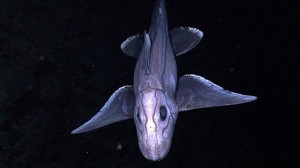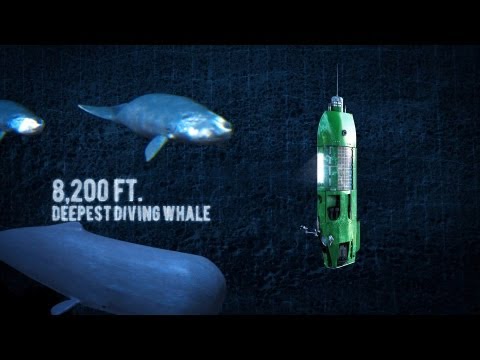
March 26, 2012
He did it!! (Updated at bottom.)
At 5:52 p.m. ET Sunday, March 25, 2012, (7:52 a.m. Monday, March 26, 2012, local Guam time), Titanic director James Cameron arrived at the Mariana Trench’s Challenger Deep, members of the National Geographic expedition have confirmed.
His depth on arrival: 35,756 feet (10,898 meters)—a figure unattainable anywhere else in the ocean.
Reaching bottom after a 2-hour-and-36-minute descent, the National Geographic explorer and filmmaker typed out welcome words for the cheering support crew waiting at the surface: “All systems OK.”

Canadian director James Cameron begins his descent to the deepest known point in any of the world’s oceans — the Challenger Deep in the Pacific Ocean southwest of Guam.

Cameron is down for six hours. Will he or any of the cameras film any Sea Monsters?
….the sub’s multiple 3-D cameras will be whirring almost continually, and not just for the benefit of future audiences of planned documentaries.
“There is scientific value in getting stereo images,” Cameron said, “because … you can determine the scale and distance of objects from stereo pairs that you can’t from 2-D images.”
But, Scripps’s Bartlett said, “it’s not just the video.” The sub’s lighting of deepwater scenes—mainly by an 8-foot (2.5-meter) tower of LEDs—is “so, so beautiful. It’s unlike anything that you’ll have seen from other subs or other remotely operated vehicles.”
Right now it’s a mystery what Cameron is seeing, sampling, and filming at depth, in part because so little is known about the Challenger Deep environment.
The only glimpses scientists have had of the region, via two ROV missions, showed a seafloor covered in light gray, silky mud.
Cameron may be detecting subtle signs of life—burrows or tracks or fecal piles—said DEEPSEA CHALLENGE biological oceanographer Lisa Levin, also of Scripps, who’s monitoring the expedition from afar.
If the water’s clear, she added, Cameron may be seeing jellyfish or xenophyophores (above)—giant, single-celled, honeycomb-shaped creatures already filmed in other areas of the Mariana Trench.
“If we get lucky,” Cameron said before the dive, “we should find something like a cold seep, where we might find tube worms.” Cold seeps are regions of the ocean floor somewhat like hydrothermal vents that ooze fluid chemicals at the same temperature as the surrounding water.
Earlier this month, during a test dive near Papua New Guinea, Cameron brought back enormous shrimplike creatures from five miles (eight kilometers) down. At 7 inches (17 centimeters) long, the animals are “the largest amphipods ever seen at that kind of depth,” chief scientist Bartlett said. “And we saw one on camera that was perhaps twice that size.”
At Challenger Deep depths, though, the calcium animals need to form shells dissolves quickly. It’s unlikely—though not impossible—that Cameron is finding shelled creatures, but if he does, the discovery would be a scientific jaw-dropper.
Even if he uncovers “a rock with a shell limpet or some kind of bivalve in the mud”—such as a clam, perhaps—”that would be exciting,” Scripps’s Levin said.
Expedition astrobiologist Kevin Hand, of NASA, imagines that the life-forms Cameron might be encountering could help fine-tune the search for extraterrestrial life.
For instance, scientists think Jupiter’s moon Europa could harbor a global ocean beneath its thick shell of ice—an ocean that, like Challenger Deep, would be lightless, near freezing, and home to areas of intense pressure.
By studying the wavelengths of light, or spectra, reflected off life-forms and sediments brought up by Cameron, Hand should get a better idea of which minerals are needed for life in such an environment. This, in turn, might help him design a space probe better able to detect signs of life on Europa.
“There’s an old adage in geology that the best geologist is the one that’s seen the most rocks,” said Hand, a National Geographic emerging explorer.
“I think astrobiology could have a similar adage, in that our best capability for finding life elsewhere—and knowing it when we see it—will come from having a comprehensive understanding of all the various extremes of life on Earth.”
And for UT Dallas’s Stern, DEEPSEA CHALLENGER’s rock-sampling capability offers the opportunity to better understand our planet’s inner workings.
“Challenger Deep is the deepest cut into the solid Earth,” Stern said, “and this gives us a chance to see deeper into the Earth than anywhere else.”
Once the trench-dive data, specimens, and imagery have been analyzed, National Geographic magazine plans to reveal the full results in a special issue on next-generation exploration in January 2013.
Read more here.

+++++++
UPDATE {Thanks to Cameron A. McCormick}:
“[James] Cameron said he had hoped to see some strange deep sea monster like a creature that would excite the storyteller in him and seem like out of his movies, but he didn’t.
He didn’t see tracks of animals on the sea floor as he did when he dove more than 5 miles deep weeks ago. All he saw were voracious shrimp-like critters that weren’t bigger than an inch.”
and
“The only thing that went wrong was the hydraulics on the system to collect rocks and critters to bring them back to land. Just as he was about to collect his first sample, a leak in the hydraulic fluid sprayed into the water and he couldn’t bring anything back.”
Source.
So, what made those tracks at five miles down? 🙂
About Loren Coleman
Loren Coleman is one of the world’s leading cryptozoologists, some say “the” leading living cryptozoologist. Certainly, he is acknowledged as the current living American researcher and writer who has most popularized cryptozoology in the late 20th and early 21st centuries.
Starting his fieldwork and investigations in 1960, after traveling and trekking extensively in pursuit of cryptozoological mysteries, Coleman began writing to share his experiences in 1969. An honorary member of Ivan T. Sanderson’s Society for the Investigation of the Unexplained in the 1970s, Coleman has been bestowed with similar honorary memberships of the North Idaho College Cryptozoology Club in 1983, and in subsequent years, that of the British Columbia Scientific Cryptozoology Club, CryptoSafari International, and other international organizations. He was also a Life Member and Benefactor of the International Society of Cryptozoology (now-defunct).
Loren Coleman’s daily blog, as a member of the Cryptomundo Team, served as an ongoing avenue of communication for the ever-growing body of cryptozoo news from 2005 through 2013. He returned as an infrequent contributor beginning Halloween week of 2015.
Coleman is the founder in 2003, and current director of the International Cryptozoology Museum in Portland, Maine.
Filed under Breaking News, CryptoZoo News, Sea Monsters, Sea Serpents